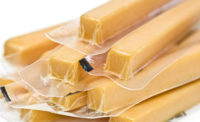"Attention, Kmart Shoppers!"

“Attention, Kmart Shoppers!”
Consumers are lining up to buy the retail icon’s redesigned, repackaged, rebranded Essential Home line.
By Kate Bertrand
Before Ikea, before Target and before Wal-Mart…there was Kmart, with its throngs of bargain-hungry shoppers and frequent Blue Light Specials. Based in Troy, Mich., Kmart defined discount retailing in the mid-twentieth century.
Fast-forward 40 years, after Kmart’s descent into and emergence from bankruptcy and, more recently, its acquisition of Sears, Roebuck and Co. Today, Kmart is remaking itself, both as an organization and as a store.
The in-store transformation includes a new look for goods on shelves; Kmart is taking a fresh tack with the products it sells and how it brands and packages them.
Before the massive redesign/rebranding effort was started last fall, Kmart’s proprietary home-products line was known as Home Essentials. The retailer changed that in the revitalization and, in March 2005, began rolling it out as the newly minted Essential Home brand.
The first step in the relaunch was to add a more contemporary look and feel to the products in the line, which ranges from tea towels and dishes to futons and armoires. After that was completed, Kmart addressed another key challenge: the packaging.
The design team at Kmart collaborated with the design and branding specialists at New York-based G2 Worldwide to rework the packaging in a remarkably tight time frame—just six months from drawing board to store shelf.
“Home Essentials needed a face-lift, and we put together a concept to cross-merchandise products between categories, so kitchen tables related to tableware, which related to kitchen draperies, which related to rugs, which related to kitchen utensils,” says Matthew Morris, divisional vice president of home product design at Kmart.
“We wanted more synergy between products and departments, and the way to achieve that was through a rebranding,” he adds. “We wanted Essential Home to have a lot more shelf presence than Home Essentials.”
A central challenge in executing the strategy was coming up with a design template that would work across the entire brand. The initial retail rollout includes roughly 5,000 SKUs across every home-product category, from soft goods—bed and bath textiles and rugs—to hard goods such as furniture, dishes, small appliances and plastic storage containers.
Package structures that fall into the mix include folding cartons, hang tags, belly bands, die-cut paperboard structures and paperboard labels stapled or shrink-wrapped to the product.
“One of the focuses of the package redesign was to have a consistent style and brand image for all categories—the lamp packaging looks the same as the towel packaging,” says Mark Maxwell, director of packaging development at Kmart.
“With the old Home Essentials brand, we had one consistent logo. However, the packaging shapes and colors changed for different product categories. Brand equity was diluted,” he says.
Another goal was to make the product, not the package, stand out. “It was about letting the new product shine and not overwhelming the product with the packaging,” says Jason Press, senior partner and director of client services at G2.
Consequently, the look and feel of Essential Home packaging is understated yet elegant. The simple non-intrusive design works well with the bright colors, patterns and textures in the brand family and also signals product quality to the consumer.
“The overall theme is an invitation,” says Maxwell. “It’s a classic look that invites the customer into the product and into a better shopping experience.”
The welcoming look is apparent in the user-friendliness of the new brand mark, a capital ‘E’ in script typeface set inside a black-bordered box. Completing the logo, the Essential Home name is centered beneath the mark in a sans serif typeface.
The style bible
To ensure a consistent look and feel across so many product categories and package structures, G2 created a comprehensive visual-identity style guide—a bible for Kmart designers developing the new packages worldwide.
The 51-page style guide addresses every aspect of how an Essential Home package should look, including specified Pantone colors, product photography, typography, logo size and placement and the relationship between various graphic and text elements and point sizes for borders and line drawings.
In the photography section, the style guide explains how to light products for overhead-silhouetted and straight-on silhouetted photos. It also describes how to photograph draping items like curtains—the item should be shot straight on, with no visible curtain rods or other fixtures, and the fabric should hang naturally.
The guide even provides rules for writing package copy, with approved spellings for problematic words like “rustproof” and “scrubber” as well as punctuation principles (“only use hyphenation for compound modifiers”).
“Because we wanted this brand to be consistent across every kind of packaging, we kept everything extremely minimal, and we made rules about what goes on each facing of the package,” says Diane DePaolis, a partner at G2 and the chief creative member of G2’s Essential Home team.
According to G2’s guidelines, the only elements that may appear on the front of any Essential Home package are, from top to bottom:
• The logo.
• A photograph of the product.
• The generic name of the product, such as “kitchen towels” or “ice pop tray.” This appears in script typeface, all lower case, and product quantity may be included, but not the type and color.
• The product’s physical dimensions and features such as “machine washable” or “bulb not included.”
These graphic and text elements are enclosed with a rectilinear, black-line border that frames the information and reinforces the invitation theme.
Guidelines for what may appear on the back of an Essential Home package are equally specific. For example, in the case of sheets, the back of the wrap-around label would include:
• The Essential Home logo, reduced 45 percent from the size of the logo on the front panel.
• The package’s contents, with more detail than the front panel.
• The product’s composition, such as “100% cotton.”
• Care instructions in English and Spanish.
The style guide addresses a variety of structures, including rectangular packages in horizontal and vertical formats, square boxes, unusual die-cut sleeves and countertop displays.
The guidelines for creating a carton or box spell out how information must be presented on the package’s front, back, side, top and bottom panels. The front and back panels are identical, and the side panels also match each other.
Components on the side panels include the logo, the product’s features and name along with a line drawing of the product created using a one-point rule. The bottom panel also displays the logo, as well as the item’s Universal Product Code. The carton’s top panel is printed only with the name of the product, such as “table lamp.”
Dotting the i’s
By strictly defining every design choice, G2 streamlined the package-design process for Kmart. And speed of design was a critical issue, in light of the tight timeline the retailer had developed and the number of SKUs in its private-label product family.
The style guide provides packaging designers with a detailed formula for putting all of the text and graphic elements together in a consistent manner. “If we had three designers working on packaging for three different products, they didn’t have to re-invent the wheel,” DePaolis explains.
For the initial launch phase, G2 created package designs for 600 SKUs, using about 100 different packaging structures and formats. Equipped with G2’s designs and the style guide, Kmart and its design agencies around the world went on to design the remaining packages.
“G2 created a clear packaging style up-front, working with a vision our corporation had for the brand. It’s the most thorough packaging style guide I’ve seen,” says Kmart’s Maxwell. “For Kmart’s in-house packaging group, adhering to the style guide made it easy to dot the ‘i’s’ and cross the ‘t’s’.”
The style guide provides direction not only for the core Essential Home product line, but also for line extensions like Essential Home Kids, Harvest and Holiday. Although the logo and graphic layout of the packaging remains the same for such offerings, their use of color varies.
The Essential Home Kids packaging sports the same neutral background color as the main Essential Home product packaging—but it includes the addition of flat art in a bright shade of turquoise.
The in-line experience
Although it’s still early in the launch of the Essential Home brand, Kmart management is encouraged by positive consumer response. The company defines its target customers as shoppers looking for quality and style at a value price; the rebranded, repackaged line of home products apparently is hitting the mark squarely.
“Our sales associates are saying customers are spending time looking at the products and touching the packaging. They’re having a different experience than they’ve had previously in our stores. They can tell a lot more thought is being put into the packaging,” says Kmart’s Morris. BP
The author, Kate Bertrand, is a San Francisco-based writer specializing in packaging, business and technology. Contact her at kate.bertrand@sbcglobal.net.
Where to go for more information...
Package design and brand consulting. At G2 Worldwide, contact Jessica Owen-Ward at 212.616.9023 or jowenward@g2.com.
WHAT’S IN A NAME?
One of the first steps Kmart took to revitalize its Home Essentials product line was to change the brand name to Essential Home. Although the new brand has exactly the same number of SKUs and the same pricing as the old brand, the name change—together with the product and packaging redesign—is turning shoppers’ heads.
For the Kmart customer, seeing the Home Essentials name reversed is “huge”, according to Matthew Morris, divisional vice president of home product design for Kmart “If you put the old packaging next to the new packaging, the customer thinks it’s two different things, which is exactly what we wanted,” he says. “Essential Home sounds like a much stronger statement. It sounds definitive and authoritative, and it says these are day-in, day-out products that consumers need. It defined our viewpoint in the home area.”
Looking for a reprint of this article?
From high-res PDFs to custom plaques, order your copy today!







